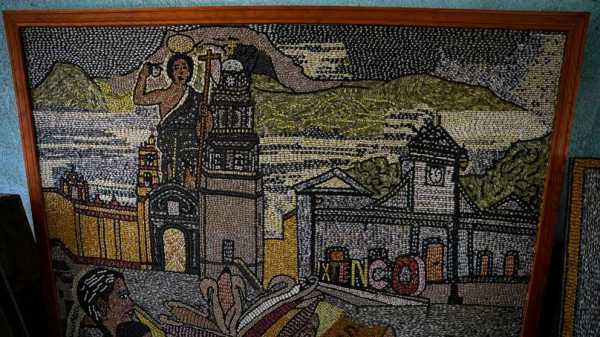
IXTENCO, Mexico — On the slopes of the Malinche volcano, Juan Vargas starts the dawn routine he’s had since childhood, carefully checking stalks of colorful native corn. For years, Vargas worried that these heirloom varieties — running from deep red to pale pink, from golden yellow to dark blue — passed down from his parents and grandparents would disappear. White corn long ago came to dominate the market and became the foundation of Mexicans’ diet.
But now, the heirloom corn Vargas grows is in vogue. It accounts for 20 of the 50 acres on his farm in Ixtenco, in the central state of Tlaxcala. Vargas, 53, remembers just one acre reserved for it 2010, when demand was virtually zero and prices low. Fueled largely by foreign demand, the corn in its rainbow of colors has become more profitable for him than the white variety.
Vargas is among farmers in Mexico who've been holding on to heirloom strains for generations, against a flood of industrially produced white corn. They're finding a niche but increasing market among consumers seeking organic produce from small-scale growers and chefs worldwide who want to elevate or simply provide an authentic take on tortillas, tostadas and other corn-based pillars of Mexican food.
Corn is the most fundamental ingredient of Mexican cuisine, and it's never far from the national conversation. Amid President Andrés Manuel López Obrador’s move to ban the importation of genetically modified corn and his imposition of a 50% tariff on imported white corn, some scientists, chefs and others are advocating for the value of the old varieties in an increasingly drought-stricken world.
Heirloom varieties make up far less than 1% of total domestic corn production in Mexico. But for the first time in years, Vargas and others are hopeful about the crop. Some in the academic and public sectors hope to increase its production.
Vargas' heirloom corn sells for around $1.17 per kilogram abroad, more than three times the price for his white. If demand keeps growing, he’ll plant more. He boasts about his colorful “little corn” that travels the globe.
“People abroad validated us,” he said.
________
In Brooklyn, Mexican chef Zack Wangeman and his wife, Diana, have been running their tortilla shop and restaurant, Sobre Masa, since 2021. Their dishes and corn masa, which they sell to other New York restaurants, are made with heirloom Mexican corn from small farms.
Wangeman, 31, believes tortillas made from that corn have gained a foothold because for many they evoke a “country flavor … that taste of toasted corn” that is uniquely Mexican.
“When you use hybrid corn, genetically modified corn or whatever other option there is, it doesn’t give you that nostalgic flavor,” said Wangeman, who was born in the southern state of Oaxaca.
He was drawn to the corn by a chef friend who returned from a food fair raving about it. Wangeman got in touch with Tamoa, a company that since 2016 has promoted the heirloom corn grown by about 100 families in central and southern Mexico to foreign markets.
Across Mexico, about 60,000 tons of heirloom corn is produced annually. It's a tiny fraction of the 23 million tons of white corn grown on an industrial scale to meet domestic demand for human consumption and the 16.5 million tons of yellow corn that Mexico imported last year – mostly from the U.S. – for industrial and animal feed use.
It's unclear how much of the heirloom corn goes abroad — Mexico doesn't keep export data for the crop. But Rafael Mier, director of the Mexican Corn Tortilla foundation, said it's clear exports of heirloom corn are growing based on the increasing number of tortillerias and restaurants buying it, especially in the U.S.
In Las Vegas, chef Mariana Alvarado said she began getting native corn through Tamoa and Los Angeles-based Masienda for tortillas, tostadas, tamales and the masa she sells in markets and online about four years ago.
At the time, she said, maybe 20 chefs in the U.S. used native corn — she estimates that's now doubled.
Little by little, Alvarado said, she built a client list of Latinos and fans of Mexican cuisine looking for “organic, clean, healthy food.” She doesn't believe this is a passing fad — in fact, she expects the distinction between Mexican food that uses modified corn and more authentic fare made with heirloom strains to grow.
“Smelling them, trying them — they realized that the taste is totally different from the tortillas they were used to here in a supermarket,” Alvarado said of U.S. customers.
This year, Alvarado pointed out, a Kansas City, Mo., tortilleria that uses native Mexican corn won the Outstanding Bakery prize at the James Beard awards – the Oscars of the food world.
“We’re making noise as tortilla-makers here in the United States, bringing native corn,” Alvarado said.
________
Under a blazing sun and large sombrero, agronomist Gerardo Noriega gave final instructions to a group of technicians and researchers as they sowed hundreds of native corn seeds in a recently plowed field in Apizaco, Tlaxcala. Noriega, of Chapingo Autonomous University, uses the field as a large, open-air laboratory to study the benefits of native versus hybrid – crossbred — corn varieties.
Noriega’s project is one of several efforts nationwide to promote organic agriculture among small producers. The hope is to get more growers into crops that draw higher prices and help ensure the survival of Mexico’s 59 native corn varieties. At least 12 are grown in Tlaxcala, where some 232,000 acres of the 355,000 planted with corn are growing heirloom varieties.
Noriega told the group that by taking up the genetic material – seeds, plants, tissue – naturally selected over centuries in Mexico, “you can start to produce those corn varieties on a massive scale, the yellows, multicolored, reds, blues, pinks and even whites, and we would not need to mess with genetically-modified.”
The native varieties have exceptional yield and can stand 50 days of drought, he said: “There isn’t a hybrid that can tolerate those conditions.”
But most Mexican farmers are accustomed to planting crossbred corn and using fertilizer and other chemicals to improve its yield.
Heirloom corn won't be an easy sell for farmers like Isidro Caporal. He entered the Chapingo University program last year but still has crossbred corn fed with chemical fertilizers planted on most of his 25 acres.
“This corn is way ahead,” said the 79-year-old Caporal as he walked down a row of hybrid corn, already 5 feet tall. He said his crop yields more than double that of native varieties and requires less of his time.
He conceded that this year’s drought hit his hybrid corn hard. “I know that I won’t be able to sell those cobs because they were really small, but it doesn’t matter," he said. "I can hold onto them to eat at home.”
For others, President López Obrador’s argument about potential health risks of genetically modified corn rings true. His move to ban the importation of GMO corn — modified in the lab to resist pests and herbicides — prompted a trade tiff with the United States and Canada.
The World Health Organization has said generally that genetically modified foods “on the international market have passed safety assessments and are not likely to present risks for human health.”
But Berenice Pérez, 35, believes the heirloom corn varieties she grows are healthier, as well as tastier. She left Mexico’s capital three years ago and moved to rural Las Mesas in Tlaxcala. Her mother had died of cancer, and she sought a healthier lifestyle.
“A lot of people say we’re crazy,” Pérez said. “We’re not going to become millionaires, but I think that wealth isn’t so much found in the economic as in nutrition and in what we leave for those who come after us.”
Sourse: abcnews.go.com






